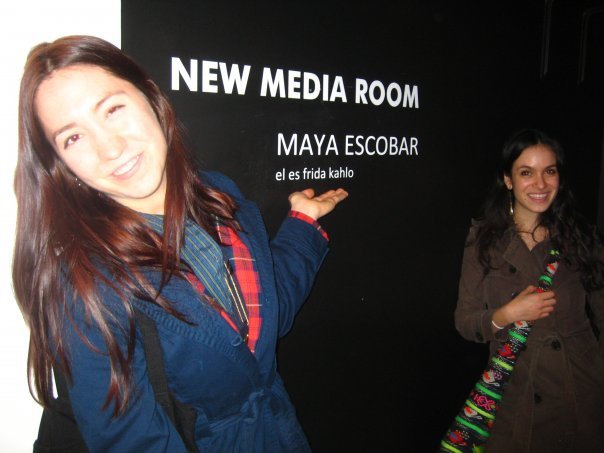 an example of my Internet ArtLast week I had the on honor of being interviewed by my papi on Sí Se Puede. We talked about Internet art, the implications of growing up online, linguistic performances on twitter, public vs private, and more.If you missed it you can listen here:[audio http://mayaescobar.com/Maya%20Escobar%20-%203-6-2011.mp3]
an example of my Internet ArtLast week I had the on honor of being interviewed by my papi on Sí Se Puede. We talked about Internet art, the implications of growing up online, linguistic performances on twitter, public vs private, and more.If you missed it you can listen here:[audio http://mayaescobar.com/Maya%20Escobar%20-%203-6-2011.mp3]
THE WORLD IS WATCHING ARIZONA
(via guardian.co.uk article by Roberto Cintli Rodriguez)
Arizona's cultural genocide law
Legislators in Arizona are pursuing a white supremacist campaign to erase Mexican American presence from teaching
The onslaught in Arizona of reactionary and immoral racially-based laws has managed to attract worldwide attention. The brown peoples of this state are being relentlessly persecuted by a majority population that wants to forcefully remove us and suppress our rights and deny our humanity. Here, the state has even gone so far as to, via HB 2281, to prohibit the teaching of ethnic studies in Arizona schools.
Unquestionably, the brown peoples of this state are treated as less than human. Not everyone treats us this way – just the majority: mostly conservative Republicans, many of them with a supremacist ideology. Their general attitude is: if you're brown (read Mexican), get the hell out of our God-given country. And for those of you who remain, either assimilate and abide by our [contrived and unconstitutional] laws or face the full wrath of the state.
There is embedded hate against brown peoples in Arizona – the kind associated with the 1800s, a time when the United States forcefully annexed half of Mexico. All of it is thinly veiled under the guise of opposition to "illegal immigration" and "border enforcement". However, the battle here is actually civilisational: brown peoples, many of whom have been here for hundreds, if not thousands, of years, represent the unfinished business of Manifest Destiny. For conservatives, we represent a return to a past in which we are viewed as a conquered, subhuman species. This brazen attitude informs all the recent anti-Mexican and anti-immigrant bills, proposed laws that long for a return to an idyllic past, which, in fact, never existed.
Aside from HB 2281, other bills include : SB 1070 – the racial profiling law; SB 1097 – the proposed law that will require children to identify the immigration status of their parents; and HB 2561/SB 1308 and HB 2562/SB1309 – bills that seek to nullify birthright citizenship (guaranteed by the 14th amendment ) to children whose parents cannot prove their legal status.
And now, state legislators have introduced the most reactionary bill of them all: SCR 1010 (pdf). This bill seeks to exempt Arizona from international laws. With this bill, these legislators are acknowledging that all their anti-Mexican laws are also outside of international law.
AND read more about HB 2561/SB 1308 (via AlterNet article by Valeria Fernández)
Arizona Bill Would Create Second-Class Citizenship for US-Born Children of Undocumented Immigrants
A baby born in Arizona to two undocumented parents would have a birth certificate that indicates he is not a U.S. citizen under new legislation introduced in Arizona’s State Capitol on Thursday.
The bills (identical in House and Senate versions, HB 2561/SB 1308 and HB 2562/SB1309) will certainly be challenged in federal court and are already steering a polarizing debate in a state known across the nation as a laboratory for anti-illegal-immigrant policies.
CPS Students Campaign for Miguel del Valle, Video Goes Viral: PRESS RELEASE
FOR IMMEDIATE RELEASE (please forward or repost)
CPS Students Campaign for Miguel del Valle, Video Goes Viral
Tuesday, February 1, 2011, Chicago – High school students may not vote, but they can still impact elections. On Sunday, January 29, students from Sullivan HS in the Rogers Park neighborhood on the northside, wrote and starred in a campaign ad for Miguel del Valle that got over 1,000 hits in the first 48 hours on YouTube and Facebook. Their message is clear, Del Valle is the candidate who will invest in public education for all students, who like them who do not go to selective enrollment or charter schools. No press outlets caught Rahm Emanuel's slip up, played twice in the video, until today when the Huffington Post picked up the story.Christina Henriquez, Gerardo Aguilar and Alexandra Alvarez, in order of appearance, scripted the video in a neighbors living room before filming outside their school an hour later. Their effort to mobilize their community to support Miguel del Valle has been developing ever since they went to the Mayoral debate for youth put on by Mikva Challenge last month. Inspired by del Valle and angered by the other candidates they got together with the Latino Club, and tireless sponsor Jackie Rosa.Last week they stopped by the newly opened northside office for Miguel del Valle, to learn to canvass their neighborhood.The video uses a clip from the WGN Mayoral debate in which Rahm Emanuel wrongly states that "if you take away Northside Prep and Walter Payton, the seven best performing schools are all charters". The next seven in fact, the top nine performing Chicago schools are all public. The video clearly questions anyone who would vote for a Mayor who does not care enough about the students in public school to even do his homework. Delivered with passion and confidence, the last words the students leave us ring true "you want a real school turnaround? Invest in us!".Watch the video here: http://www.youtube.com/watch?v=afonAiiMTm8Press Contacts:Carlos [email protected] @cdrosaJackie [email protected] @floreciendo_coSandi [email protected] @floreciendo_co
Escobar-Morales Establishes Online Marketing Agency
As a follow up to Are You My Other? our current Internet based self-portrait dialogue exchange project, Escobar-Morales is establishing an online marketing agency. Acting as designers, distributors, and promo models, we plan to produce a series of advertisements addressing contentious topics in the news, such as Arizona’s SB-1070 and the Dream Act.
Wonder Women Residency: New News is Old News
2011 is going to be a good year. I can feel it already. In addition to our upcoming presentation at the 2011 PCA/ACA Conference this April, Andria and I were also accepted to the Wonder Woman Residency at the _gaia studio, in New Jersey. Curated by Maya Joseph-Goteiner and Doris Caçoilo, this year's theme is: New News is Old News.
New News is Old NewsIn our society, the importance of news has shifted; some would argue that it has been elasticized or else devalued. As the blogosphere replaces the daily newspaper as the purveyor and distributor of breaking news, the reporting of events is no longer filtered by the journalist/editor. Instead the voice of news is replaced by a dynamic exchange of information.
Already, online, the same article that has appeared black on white in the early print edition has been updated, corrected or even replaced on the web. Newspaper stories no longer fit the Merriam-Webster Dictionary definition of news as “a report of recent events: previously unknown information.” In many respects, we have created an endless source of updated information online, a bottomless pit of patter. We cannot possibly consume all the news and commentary published online, and while few people have the time to read the entire newspaper, even fewer can keep up with the minute-to-minute updates via Twitter, blogs, online publications, and RSS feeds.
A residency that focuses on the ways in which news is presented, represented, distributed, and modified within the space of the web... hmm... can you think of anything more perfect for us?So what are we doing?I won't spill all the beans yet, but here is an excerpt from our preliminary proposal:
Our project takes its cue from the recent Buy Life Digital Death campaign, where celebrities volunteered their virtual lives (activity on Twitter and Facebook) with the goal of raising $1 million for children and families in Africa and India affected by HIV/AIDS. We were fascinated by their use of highly stylized, seductive images of Kim Kardashian (and other participating celebrities) lying in a coffin, and the role these images play in the dissemination of news coverage surrounding this HIV/AIDS campaign.
Almost immediately following Digital Death's inception, images of a "dead" Kardashian started appearing in news stories everywhere from CNN to Gawker. Now layered with multiple levels of history and meaning, screenshots of the sultry Kardashian lying in a coffin, continue to be re-distributed on personal blogs, Facebook, Tumblr and Twitter pages...
Stay tuned for more project updates here and on Are You My Other?
Emerging Paradigms in Critical Mixed Race Studies
 Come join me at the 1st annual Critical Mixed Race Studies Conference, Emerging Paradigms in Critical Mixed Race Studies, at DePaul University in Chicago, November 5-6, 2010.
Come join me at the 1st annual Critical Mixed Race Studies Conference, Emerging Paradigms in Critical Mixed Race Studies, at DePaul University in Chicago, November 5-6, 2010.
The CMRS conference brings together scholars from a variety of disciplines nationwide. Recognizing that the diverse disciplines that have nurtured Mixed Race Studies have reached a watershed moment, the 2010 CMRS conference is devoted to the general theme “Emerging Paradigms in Critical Mixed Race Studies.”Critical Mixed Race Studies (CMRS) is the transracial, transdisciplinary, and transnational critical analysis of the institutionalization of social, cultural, and political orders based on dominant conceptions of race. CMRS emphasizes the mutability of race and the porosity of racial boundaries in order to critique processes of racialization and social stratification based on race. CMRS addresses local and global systemic injustices rooted in systems of racialization.
I will be presenting at the conference on November 5th in a roundtable discussion moderated by Laura Kina, on the use of arts in challenging racial ideologies. My next post will include more information on the roundtable and on my fellow panelists: Alejandro T. Acierto, Tina Ramirez, and Jonathan Reinert.
el es frida kahlo at the gallery
el es frida kahlo is currently on view in the New Media Room at the Bruno David Gallery in St. Louis, MO.
el es frida kahlo, 2007-present
Frida Kahlo played with the identity that she wanted to project and the identity that was placed on her by others. Kahlo used her clothing, political affiliations, sexual escapades, and personal traumas, to create a character that informed her body of work. She inscribed her identity, painting her image over and over, constructing a mythology around her persona.
In el es frida kahlo I confront the ambivalence I experience as a result of my simultaneous obsession with Frida Kahlo and weariness towards her commodification. Viewed from a tiny pinhole, dressed as Kahlo, I stand before a reproduction of one of her self portraits. With a mixture of rage, anxiety, and complete fear, I chant “el es Frida Kahlo, ella es Frida Kahlo, el es Frida Kahlo, yo soy, yo soy, yo soy Frida Kahlo,” he is Frida Kahlo, she is Frida Kahlo, I am, I am, I am Frida Kahlo. As I yell, the painting behind me begins to fall. I violently tear down my braids and smudge off my makeup while continuing to scream “I am Frida Kahlo, I am Frida Kahlo, yo soy Frida Kahlo!”
[youtube=http://www.youtube.com/watch?v=0BJmaYn5IIE]
el es frida kahlo at the Bruno David Gallery (video filmed and edited by Felicia Chen)
[youtube=http://www.youtube.com/watch?v=xlMPoFXRT18]
el es frida kahlo YouTube video
FREE el es frida kahlo animated gif avaliable on MayaEscobar.com
link to translation of recent review by David Sperber in Ma’arav Israeli Arts and Culture Magazine:
Frida Kahlo at the synagogue: Maya Escobar and the young Jewish-American Creation
Tzit Tzit: Fiber Art and Jewish Identity
I met Ben Schachter at the 2009 Conney Conference on Jewish Art: Performing Histories, Inscribing Jewishness, where coincidentally, we both presented Eruv themed works.In addition to making humorous Jewish themed conceptual art, Ben is a curator and is the man behind Tzit Tzit: Fiber Art and Jewish Identity. I have a few pieces from Hiddur Mitzvah included in the show.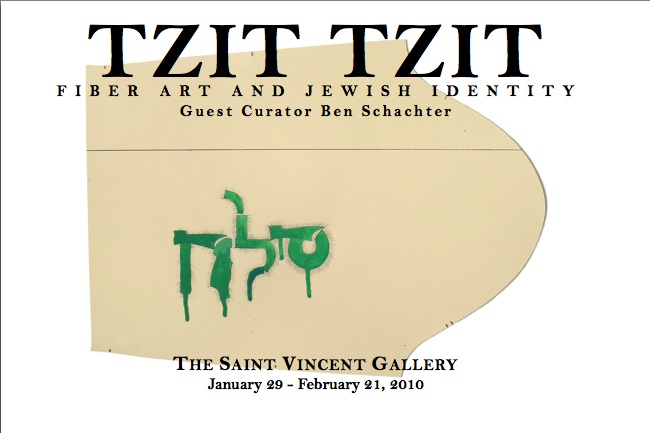 A special exhibit assembled by guest curator Ben Schachter, “Tzit Tzit: Fiber Art and Jewish Identity,” will open with a reception at The Saint Vincent Gallery in the Robert S. Carey Student Center at Saint Vincent College from 6 to 8:30 p.m. Thursday, January 28. Admission is free and open to the public.The exhibit will continue from Friday, January 29 through Sunday, February 21 during regular Gallery hours: 12 noon to 3 p.m. and 6:30 to 8:30 p.m. Tuesdays, Wednesdays and Thursdays; 12 noon to 3 p.m. Fridays, Saturdays and Sundays. The Gallery is closed on Mondays.Participating artists include Maya Escobar, Melanie Dankowicz, Carol Es, Leslie Golomb, Louise Silk and Shirah Apple.Ms. Silk will present a lecture, “Quilting and Spirituality,” at 6 p.m. Monday, February 9 in room 100 of Prep Hall.Mr. Schachter, associate professor of fine arts, will give a Gallery tour of the exhibition at 7:30 p.m. Tuesday, February 9.The exhibit was developed by Mr. Schachter. “I have been studying various aspects of Jewish art for the past three years and this exhibit is an outgrowth of that interest,” Mr. Schachter said. “The artists hail from Los Angeles, New York City, Kansas City, Illinois and Pittsburgh.”“Fiber art refers to any use of a cloth such as stitching or weaving,” he explained. “The title, Tzit Tzit, refers to the fringe on a prayer shawl, or tallis, worn by many Jews during prayer. While using thread, cloth, pattern making, stitching and other craft materials, each artists’ process creates a language derived from craft techniques that reinterprets the Old Testament, the oral law as written in the Talmud and personal histories. In so doing, both craft theory and Jewish Art are reinvigorated. I learned of these artists through Jewish art conferences I have attended, through exhibitions and through national awards. I think our students and our friends in the region will really enjoy seeing their work.”Ben Schachter is an artist whose work integrates conceptual art and Jewish law. He sees a connection between the rules artists have created to guide and limit their work and Jewish traditions. His work has been shown nationally and will be on exhibition at the Westmoreland Museum of Art in Greensburg concurrent with this exhibition. He holds an M.F.A. and M.S. degree from Pratt Institute and lives in Pittsburgh with his wife and two children.Carol Es paints images that powerfully scream of a life of hard labor. As a child she worked endless hours in a sweatshop with her family. Ms. Es' works are featured in numerous private and public collections, including the Getty Museum, Brooklyn Museum, UCLA Special Collections, the Jaffe Collection and Centre Georges Pompidou in Paris. She is also a two-time recipient of the ARC Grant from the Durfee Foundation and was recently awarded the prestigious Pollock-Krasner Fellowship.Maya Escobar’s work directly challenges gender roles and illustrates how Jewish tradition empowers women. Ms. Escobar received her master of fine arts degree from the Sam Fox School of Design & Visual Arts, Washington University in St. Louis, and her bachelor of fine arts degree from the School of the Art Institute of Chicago. She has exhibited work in Spain, Guatemala, United States, Germany and Venezuela.Melanie Dankowicz creates intricate papercut sculptures, marriage contracts, and wall art. An expansion of the medium, Dankowicz's three-dimensional forms are ephemeral lace-like paper structures, of elegant tracery that has inspired her recent metalwork. She draws inspiration from the countryside of Illinois, where she resides with Harry and their three children.Leslie Golomb exhibits her work nationally and internationally and is the recipient of numerous awards, including recognition from the National Endowment for the Arts, Pennsylvania Council on the Arts Individual Artists Fellowship Award and a State of the Art Award from the State Museum of Pennsylvania. Her work was recently included in the Three Rivers Arts Festival and Best of Pittsburgh Invitational. Ms. Golomb holds a bachelor in fine arts from Carnegie-Mellon University and a master of fine arts from the School of the Art Institute of Chicago. She served as founder and director of the American Jewish Museum of the Jewish Community Center of Greater Pittsburgh for nine years. She has returned to the studio producing prints and artists books.Louise Silk began her quest to acquire skills as a quilter after being inspired by an article in Ms. Magazine in 1971 about quilt making as a woman's art form. Over the past 30 years, her work has been included in Quilt National Biennial Exhibition of Contemporary Quilts as well as many private corporate collections such as USAirways, Paine Webber and PNC Bank. She is a certified Integrated Kabbalistic Healer. She is currently living and working from her loft in the South Side of Pittsburgh, Pennsylvania.Ms. Golumb and Ms. Silk collaborate and join their printmaking and fiber art into multilayered quilts, runners and tallisim. The images and techniques bring together American folk traditions and Jewish history in surprising ways. Ultimately the perspective of these five artists reinvigorates what Jewish Art is and can become.Shirah Apple received a master of fine arts degree from the Rinehart School of Sculpture at the Maryland Institute College of Art in 2006. She is a graduate of MICA’s post-baccalaureate certificate program and of Miami University, where she received a bachelor of science degree in business administration.Further information about the exhibition is available by contacting the Gallery at 724 805-2107, www.stvincent.edu/gallery.
A special exhibit assembled by guest curator Ben Schachter, “Tzit Tzit: Fiber Art and Jewish Identity,” will open with a reception at The Saint Vincent Gallery in the Robert S. Carey Student Center at Saint Vincent College from 6 to 8:30 p.m. Thursday, January 28. Admission is free and open to the public.The exhibit will continue from Friday, January 29 through Sunday, February 21 during regular Gallery hours: 12 noon to 3 p.m. and 6:30 to 8:30 p.m. Tuesdays, Wednesdays and Thursdays; 12 noon to 3 p.m. Fridays, Saturdays and Sundays. The Gallery is closed on Mondays.Participating artists include Maya Escobar, Melanie Dankowicz, Carol Es, Leslie Golomb, Louise Silk and Shirah Apple.Ms. Silk will present a lecture, “Quilting and Spirituality,” at 6 p.m. Monday, February 9 in room 100 of Prep Hall.Mr. Schachter, associate professor of fine arts, will give a Gallery tour of the exhibition at 7:30 p.m. Tuesday, February 9.The exhibit was developed by Mr. Schachter. “I have been studying various aspects of Jewish art for the past three years and this exhibit is an outgrowth of that interest,” Mr. Schachter said. “The artists hail from Los Angeles, New York City, Kansas City, Illinois and Pittsburgh.”“Fiber art refers to any use of a cloth such as stitching or weaving,” he explained. “The title, Tzit Tzit, refers to the fringe on a prayer shawl, or tallis, worn by many Jews during prayer. While using thread, cloth, pattern making, stitching and other craft materials, each artists’ process creates a language derived from craft techniques that reinterprets the Old Testament, the oral law as written in the Talmud and personal histories. In so doing, both craft theory and Jewish Art are reinvigorated. I learned of these artists through Jewish art conferences I have attended, through exhibitions and through national awards. I think our students and our friends in the region will really enjoy seeing their work.”Ben Schachter is an artist whose work integrates conceptual art and Jewish law. He sees a connection between the rules artists have created to guide and limit their work and Jewish traditions. His work has been shown nationally and will be on exhibition at the Westmoreland Museum of Art in Greensburg concurrent with this exhibition. He holds an M.F.A. and M.S. degree from Pratt Institute and lives in Pittsburgh with his wife and two children.Carol Es paints images that powerfully scream of a life of hard labor. As a child she worked endless hours in a sweatshop with her family. Ms. Es' works are featured in numerous private and public collections, including the Getty Museum, Brooklyn Museum, UCLA Special Collections, the Jaffe Collection and Centre Georges Pompidou in Paris. She is also a two-time recipient of the ARC Grant from the Durfee Foundation and was recently awarded the prestigious Pollock-Krasner Fellowship.Maya Escobar’s work directly challenges gender roles and illustrates how Jewish tradition empowers women. Ms. Escobar received her master of fine arts degree from the Sam Fox School of Design & Visual Arts, Washington University in St. Louis, and her bachelor of fine arts degree from the School of the Art Institute of Chicago. She has exhibited work in Spain, Guatemala, United States, Germany and Venezuela.Melanie Dankowicz creates intricate papercut sculptures, marriage contracts, and wall art. An expansion of the medium, Dankowicz's three-dimensional forms are ephemeral lace-like paper structures, of elegant tracery that has inspired her recent metalwork. She draws inspiration from the countryside of Illinois, where she resides with Harry and their three children.Leslie Golomb exhibits her work nationally and internationally and is the recipient of numerous awards, including recognition from the National Endowment for the Arts, Pennsylvania Council on the Arts Individual Artists Fellowship Award and a State of the Art Award from the State Museum of Pennsylvania. Her work was recently included in the Three Rivers Arts Festival and Best of Pittsburgh Invitational. Ms. Golomb holds a bachelor in fine arts from Carnegie-Mellon University and a master of fine arts from the School of the Art Institute of Chicago. She served as founder and director of the American Jewish Museum of the Jewish Community Center of Greater Pittsburgh for nine years. She has returned to the studio producing prints and artists books.Louise Silk began her quest to acquire skills as a quilter after being inspired by an article in Ms. Magazine in 1971 about quilt making as a woman's art form. Over the past 30 years, her work has been included in Quilt National Biennial Exhibition of Contemporary Quilts as well as many private corporate collections such as USAirways, Paine Webber and PNC Bank. She is a certified Integrated Kabbalistic Healer. She is currently living and working from her loft in the South Side of Pittsburgh, Pennsylvania.Ms. Golumb and Ms. Silk collaborate and join their printmaking and fiber art into multilayered quilts, runners and tallisim. The images and techniques bring together American folk traditions and Jewish history in surprising ways. Ultimately the perspective of these five artists reinvigorates what Jewish Art is and can become.Shirah Apple received a master of fine arts degree from the Rinehart School of Sculpture at the Maryland Institute College of Art in 2006. She is a graduate of MICA’s post-baccalaureate certificate program and of Miami University, where she received a bachelor of science degree in business administration.Further information about the exhibition is available by contacting the Gallery at 724 805-2107, www.stvincent.edu/gallery.
CHAP OPENING 12/6
Show opens 12/6. If you haven't seen it, check out guest post I did on MyJewishLearing.com about my father's and my piece in the show.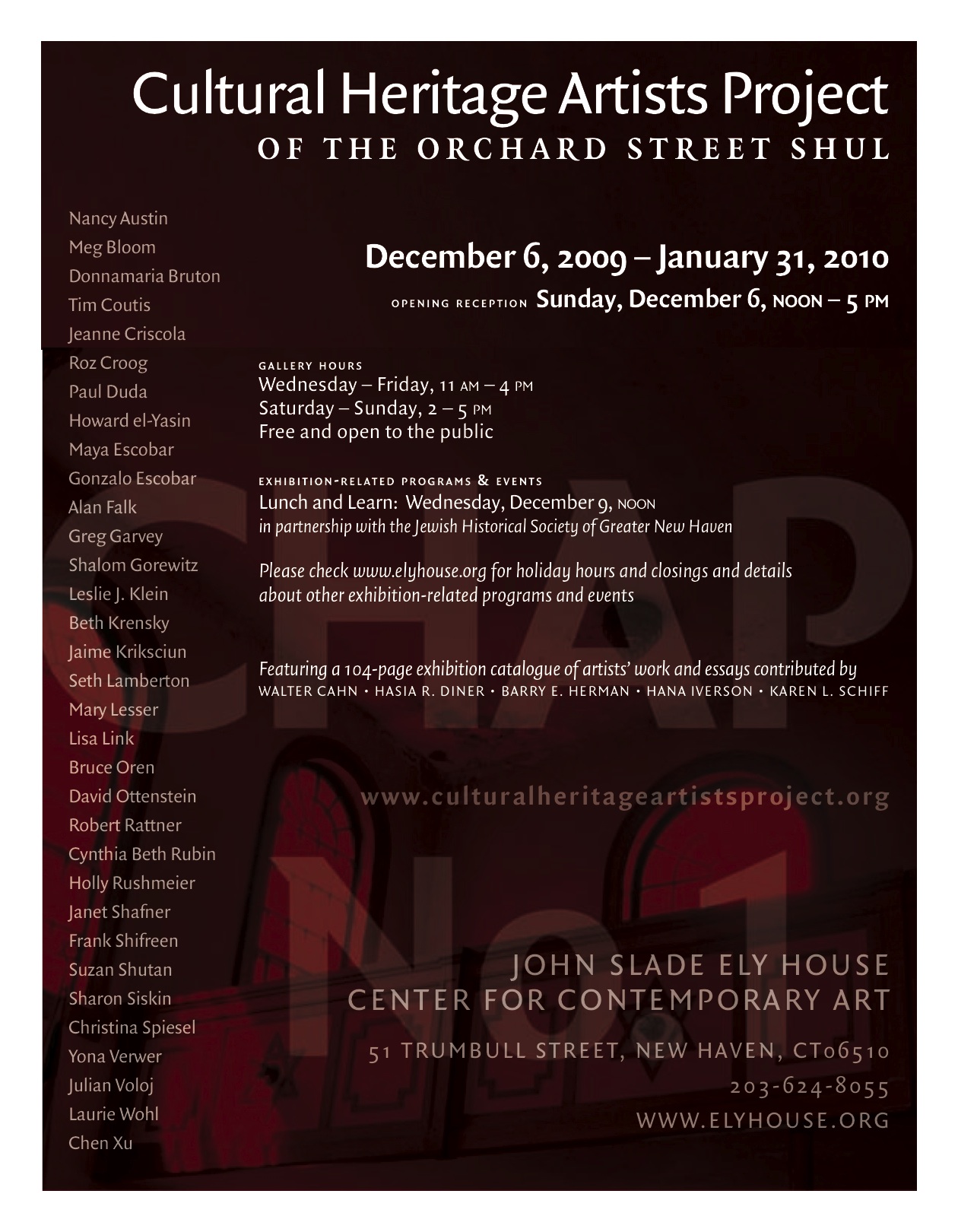
Appropriating and Recontextualizing Google Image Search Results
Part 1 of an article I wrote for jewishinstlouis.orgEvery art student learns about the fair use principle, granting us permission to use any image in our artwork as long as we transform it so that it conveys new meaning. But beyond that all-encompassing definition, we don’t know what transgressions, if any, we are actually committing. Recently in the news is the preemptive lawsuit artist Shepard Fairey filed against the Associated Press. According to Fairey the AP threatened to sue him unless he pays royalties for the image that he used as source material for his now famous campaign poster of Barack Obama. Fairey argues that he is protected by the fair use principle. He claims that his intention was not to reproduce any particular image, but instead was to capture a specific gaze representative of the ideas of hope and change.In an interview on NPR, Fairey declared he was going forward with this suit on behalf of all artists, the thousands of artists that created their own campaign images in the same grassroots manner, pulling images from the web in support of the message of hope, change and a new administration in Washington.
Recently in the news is the preemptive lawsuit artist Shepard Fairey filed against the Associated Press. According to Fairey the AP threatened to sue him unless he pays royalties for the image that he used as source material for his now famous campaign poster of Barack Obama. Fairey argues that he is protected by the fair use principle. He claims that his intention was not to reproduce any particular image, but instead was to capture a specific gaze representative of the ideas of hope and change.In an interview on NPR, Fairey declared he was going forward with this suit on behalf of all artists, the thousands of artists that created their own campaign images in the same grassroots manner, pulling images from the web in support of the message of hope, change and a new administration in Washington.
screen shot of: first page of google image search results for "Barack Obama"
I am fascinated by Fairey’s implication that the process of appropriating and re-contextualizing Google image search results might be considered a grassroots action. As an artist, I frequently use images that that I find on Google. Like Fairey suggested, my motivation for using these images is to highlight the search itself, not the derivative image.Perhaps then, these cyber Robin Hoodian actions—using and transforming Google image search results—are capable of changing the structures that control the dissemination of information. After all, the order that information appears in Google searches is determined by the amount of people searching any given topic. And as a result of the Fairey’s appropriation, his campaign poster may be forever linked to Obama’s presidency.
email from President Obama
Obama’s popularity can be credited to his skillfully constructed presidential campaign that effortlessly linked his name to hope. I was quick to jump onto Obama’s online campaign message of hope. Like many others, I subscribed to his twitter, facebook, and YouTube pages. I now get weekly emails from him and I even have a blog on his site…
Negotiating Diaspora Identities Through New Media
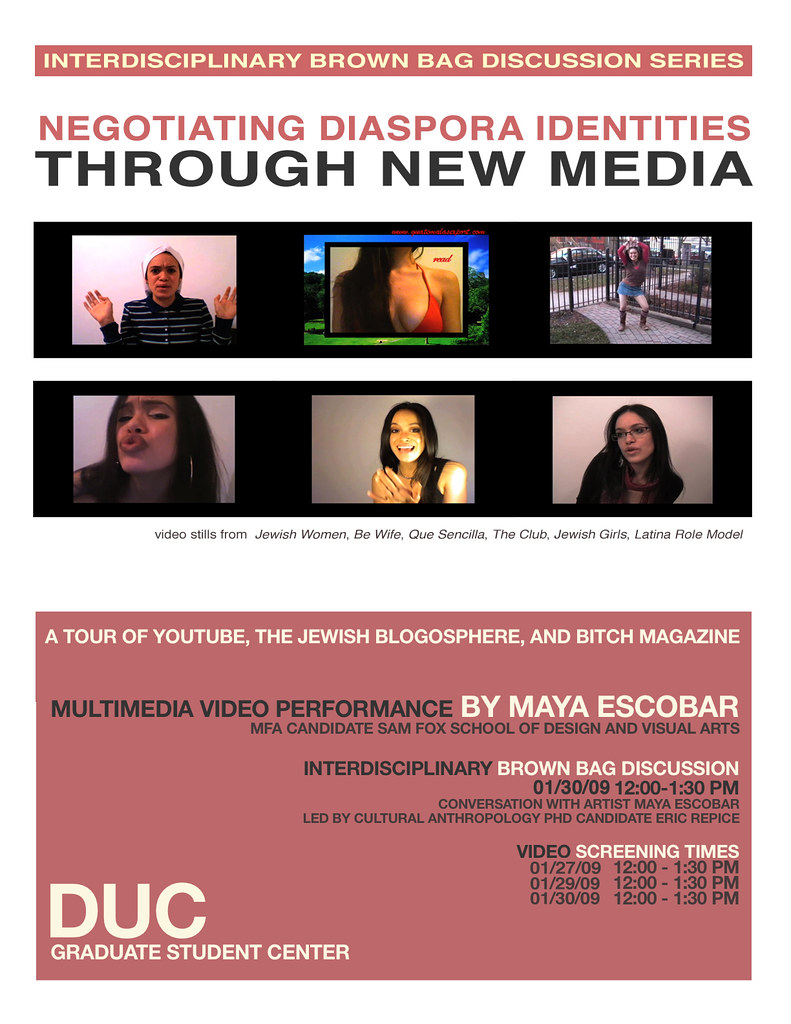 Join PhD Anthropology Candidate Eric Repice and MFA Candidate Maya Escobar in a brown bag lunch discussion concerning transnational, transcultural, and hybrid negotiations of identity through new media.How do these discussions vary between our fields?
Join PhD Anthropology Candidate Eric Repice and MFA Candidate Maya Escobar in a brown bag lunch discussion concerning transnational, transcultural, and hybrid negotiations of identity through new media.How do these discussions vary between our fields? Eric Repicefor more information on Eric Repice visit http://www.artsci.wustl.edu/~esrepice/homefor more information on Maya Escobar visit http://mayaescobar.com[youtube=http://www.youtube.com/watch?v=3li_mT--f-A][youtube=http://www.youtube.com/watch?v=G-GDmDcSH4g][youtube=http://www.youtube.com/watch?v=whLYM9o946w][youtube=http://www.youtube.com/watch?v=Vz2fhmRzCOA][youtube=http://www.youtube.com/watch?v=14bv0-dzMIc][youtube=http://www.youtube.com/watch?v=NNAxEUEE43Y]
Eric Repicefor more information on Eric Repice visit http://www.artsci.wustl.edu/~esrepice/homefor more information on Maya Escobar visit http://mayaescobar.com[youtube=http://www.youtube.com/watch?v=3li_mT--f-A][youtube=http://www.youtube.com/watch?v=G-GDmDcSH4g][youtube=http://www.youtube.com/watch?v=whLYM9o946w][youtube=http://www.youtube.com/watch?v=Vz2fhmRzCOA][youtube=http://www.youtube.com/watch?v=14bv0-dzMIc][youtube=http://www.youtube.com/watch?v=NNAxEUEE43Y]
Hope in the STL POST
'Hope' springs anew for Washington University grad students
 November 19, 2008 -- Carianne Noga, a graduate student of art at Washington University, ties tags of hope onto a sculpture outside the University City Post-Office. Noga and fellow student Maya Escobar started soliciting people's hopes to place on the sculpture. (Christian Gooden/P-D)By Margaret GillermanST. LOUIS POST-DISPATCH11/29/2008UNIVERSITY CITY — Georgia O'Keeffe found inspiration in the light and shapes of New Mexico. Mary Cassatt found hers in mothers and children. Maya Escobar and Carianne Noga, two graduate students at Washington University's Sam Fox School of Art and Design, found inspiration for their latest project from the long lines on Election Day at a Ben and Jerry's ice cream shop in the Loop.There, on the sidewalk outside the shop, which was giving away scoops of ice cream to voters, the two women felt excitement and hope among voters. They said they found that same feeling across the street in the long line of voters waiting to vote at the Loop polling place."We wanted to continue that moment and not let it peak out," Noga said.Before the polls closed, they had begun to create their "I hope…" project.They first staked out a site: outside the University City Post Office at 561 Kingsland Avenue.They then provided people with bright red tags and paint markers for them to write down their hopes for a better future.The tags then are affixed to a permanent lattice wood sculpture already on site outside the Post Office."As difficult as it can be sometimes to voice our wishes and dreams, it can be strengthening," the artists say in explaining their mission. "We can be reminded of the rest of the world outside our own immediate concerns. In this period of great change and near infinite possibilities, it is time for us to voice our hopes."While the project is for all people, Escobar said it holds special meaning for young people."This is our moment to make a difference for our communities," Escobar said. "We need to be aware — of our national situation, of the economy."Many of the hopes expressed — most recorded anonymously — so far are noble and universal: "I hope for world peace" and "My hope is that hate is no longer."Some of the hopes are personal. "I hope to not fear death," wrote one.Others have a distinctly political bent: "I hope we get out of Iraq and don't go to war with Iran." And some are just fun, like the person hoping for "chocolate cake for dessert ..."A University City police officer named Hope — Reginald Hope — shared with them his own hope: for safety for police officers. A fellow officer was killed while on duty near the Loop last month.Washington University Chancellor Mark Wrighton gave his hope and "wishes for better health and greater prosperity for all."The artists also are encouraging people to submit their hopes online at togetherwehope.com.The existing sculpture outside the post office was designed in 2005 by an undergraduate architectural design studio taught by Carl Safe in the Washington University School of Architecture. University City resident Ethel Sherman had asked Safe to help create a sculpture in memory of her husband William Sherman, a Washington University biochemist who died about five years ago."It's strong like Bill and peaceful and quiet," she said. Sherman said she's thrilled about adding "I hope..." to it."This is an exciting time of change and hope," said Sherman, a retired psychologist and teacher who worked for 10 years at the Loop's Craft Alliance.The artists, both 24, come from family traditions of public service and political idealism."I grew up under the table of political meetings," says Escobar, remembering her childhood in Chicago. "My friends and I formed our first political organization when we were 11 — Students Against Child Oppression — on behalf of children in sweatshops in Mexico."Her mother is a school nurse, and her father, an educator, hosts a radio show in Chicago called "Si, Se Puede," which means "Yes, We Can." The program has been around since 1996.Noga grew up in the Washington, D.C., area and in Georgia. Her father is a psychiatrist at a state hospital, and her mother is a library director.Both artists are second-year graduate students in the two-year master's of fine arts program.The project will remain up through January. Later, the tags can be relocated to other sites and the online site will remain.University City has embraced the "I hope ..." project, according to city manager Julie Feier."It's an inspiring project," she said.
November 19, 2008 -- Carianne Noga, a graduate student of art at Washington University, ties tags of hope onto a sculpture outside the University City Post-Office. Noga and fellow student Maya Escobar started soliciting people's hopes to place on the sculpture. (Christian Gooden/P-D)By Margaret GillermanST. LOUIS POST-DISPATCH11/29/2008UNIVERSITY CITY — Georgia O'Keeffe found inspiration in the light and shapes of New Mexico. Mary Cassatt found hers in mothers and children. Maya Escobar and Carianne Noga, two graduate students at Washington University's Sam Fox School of Art and Design, found inspiration for their latest project from the long lines on Election Day at a Ben and Jerry's ice cream shop in the Loop.There, on the sidewalk outside the shop, which was giving away scoops of ice cream to voters, the two women felt excitement and hope among voters. They said they found that same feeling across the street in the long line of voters waiting to vote at the Loop polling place."We wanted to continue that moment and not let it peak out," Noga said.Before the polls closed, they had begun to create their "I hope…" project.They first staked out a site: outside the University City Post Office at 561 Kingsland Avenue.They then provided people with bright red tags and paint markers for them to write down their hopes for a better future.The tags then are affixed to a permanent lattice wood sculpture already on site outside the Post Office."As difficult as it can be sometimes to voice our wishes and dreams, it can be strengthening," the artists say in explaining their mission. "We can be reminded of the rest of the world outside our own immediate concerns. In this period of great change and near infinite possibilities, it is time for us to voice our hopes."While the project is for all people, Escobar said it holds special meaning for young people."This is our moment to make a difference for our communities," Escobar said. "We need to be aware — of our national situation, of the economy."Many of the hopes expressed — most recorded anonymously — so far are noble and universal: "I hope for world peace" and "My hope is that hate is no longer."Some of the hopes are personal. "I hope to not fear death," wrote one.Others have a distinctly political bent: "I hope we get out of Iraq and don't go to war with Iran." And some are just fun, like the person hoping for "chocolate cake for dessert ..."A University City police officer named Hope — Reginald Hope — shared with them his own hope: for safety for police officers. A fellow officer was killed while on duty near the Loop last month.Washington University Chancellor Mark Wrighton gave his hope and "wishes for better health and greater prosperity for all."The artists also are encouraging people to submit their hopes online at togetherwehope.com.The existing sculpture outside the post office was designed in 2005 by an undergraduate architectural design studio taught by Carl Safe in the Washington University School of Architecture. University City resident Ethel Sherman had asked Safe to help create a sculpture in memory of her husband William Sherman, a Washington University biochemist who died about five years ago."It's strong like Bill and peaceful and quiet," she said. Sherman said she's thrilled about adding "I hope..." to it."This is an exciting time of change and hope," said Sherman, a retired psychologist and teacher who worked for 10 years at the Loop's Craft Alliance.The artists, both 24, come from family traditions of public service and political idealism."I grew up under the table of political meetings," says Escobar, remembering her childhood in Chicago. "My friends and I formed our first political organization when we were 11 — Students Against Child Oppression — on behalf of children in sweatshops in Mexico."Her mother is a school nurse, and her father, an educator, hosts a radio show in Chicago called "Si, Se Puede," which means "Yes, We Can." The program has been around since 1996.Noga grew up in the Washington, D.C., area and in Georgia. Her father is a psychiatrist at a state hospital, and her mother is a library director.Both artists are second-year graduate students in the two-year master's of fine arts program.The project will remain up through January. Later, the tags can be relocated to other sites and the online site will remain.University City has embraced the "I hope ..." project, according to city manager Julie Feier."It's an inspiring project," she said.
[email protected] | 314-725-6758
Maya Escobar Paint 4 Peace on ABC 7 News
I just re-uploaded a better quality of this video to youtube, check it out if you missed it before
Paint 4 Peace mural on ABC "The Ñ Beat," with host Theresa Gutierrez back in 2002
Paint 4 Peace is a non-profit organization comprised of artists and activists who strive to create a culture of peace, fortify communities, and bridge the gap between humanity and politics through artistic endeavors.
Guest Post by Debbie Wolen: Ta'anit Esther and Mardge Cohen
Guest Post by Debbie Wolen*: Ta'anit Esther and Mardge CohenI had never heard of the holiday [Ta'anit Esther] until one year ago, when Rabbi Brant said that the JRF and the RRC wanted to honor Dr. Mardge Cohen for Ta'anit Esther. Mardge asked me what Ta'anit Esther was. I had never heard of it, and I have been Jewish all my life.Isaac Saposnik is working on the Philadelphia side of this RRC/Kolot "reconstruction" of Ta'anit Esther as a Jewish Day of Justice. Ta'anit Esther is described in the Book of Esther (which I did actually read for the first time, in preparation for organizing this event. It describes Esther's initial reluctance to get involved with advocating for her people. When Mordicai first told Esther about the plot, she was afraid to intervene. Apparently, her conscience and sense of justice/solidarity/responsibility was stronger than her fear, and gave her the energy and courage to intervene. Her struggle is interesting and a process that I know I face often in my life, so I can really identify with Esther's struggle. Prior to her intervention, Esther fasted, and asked the whole Jewish community to fast with her in solidarity. Thus, the Fast of Esther is one of several Jewish fast days. (It lasts from sunrise to sundown on March 20. That is why we are having East African (Ethiopian) hors d'ouerves at the March 19 observance.)I bought an Art Scroll prayer book recently, so I looked, and sure enough, Ta'anit Esther is listed as a fast day. It is not described as a Jewish day of justice, however. This is the new reconstruction of it. I also mentioned it to an Israeli fellow, and he said, "Oh, yes, sure, Ta'anit Esther, of course." But, I have asked other people who are much more knowledgeable and involved Jewish people than I, and they had not heard of Ta'anit Esther previously.When I read the Book of Esther, I was somewhat concerned about the justice described there and the assumptions I made about what the reconstructionists meant by "Jewish day for justice." The justice in Esther is revengeful and quite bloody! I asked Isaac about this. He said this Jewish Day for Justice implies social justice, the type of justice that Mardge Cohen and others in Rwanda are working for, making the lives of the survivors of the 1994 genocide better, making the lives of the poor and powerless more empowered. Well, it was obvious, but the bloody revenge in Esther is called justice, too.Mardge Cohen, MD, is a woman who has struggled with social injustice during her whole medical career. She is really a remarkable woman, and her work is on the level of Paul Farmer, in my opinion. I saw some slides she showed at our workplace in 8/2000, of her tour of HIV projects in South Africa after the 2000 International AIDS conference. I was inspired by her slides so that I started trying to educate folks at JRC about AIDS in Africa, and to raise funds for HIV projects there. I am just one of many she has inspired by her example.Here is a jewish text study by Jordan Appel Ta’anit Esther text studyThanks a lot for your interest and supportDebbie Wolen
*About Debbi:
I'm a family nurse practitioner, have worked in HIV primary care at Cook County Hospital for nearly 17 years with people who are medically indigent and suffer the indignities of poverty. I was a public health nurse before that. I have sought inspiration from many sources. My first source of inspiration was my childhood rabbi, Leonard Mervis, who gave sermons on social justice, anti-war and in support of the civil rights movement (like you, my parents insisted on my attendance through high school, every single Friday evening! So, rather than be bored, I listened to the interesting sermons.) I am a product of Cicero, Illinois. My cousins marched against Martin Luther King when I was 15. That was a radicalizing experience that affects me even today, in my middle age. Also, your mother [Tina Escobar] was the only teacher I could really relate to in my two years at Rush College of Nursing, and she only taught our class for 2 weeks!
Bitch Magazine
Acciones Plásticas was discussed in current issue of Bitch Magazine Lost and Found #38. The article is entitled The Princess Diaries: In an Age of Ostentation the J.A.P. is Back written by Julia Appel, a rabbinical student at Hebrew College.To view the full article (pdf version) click here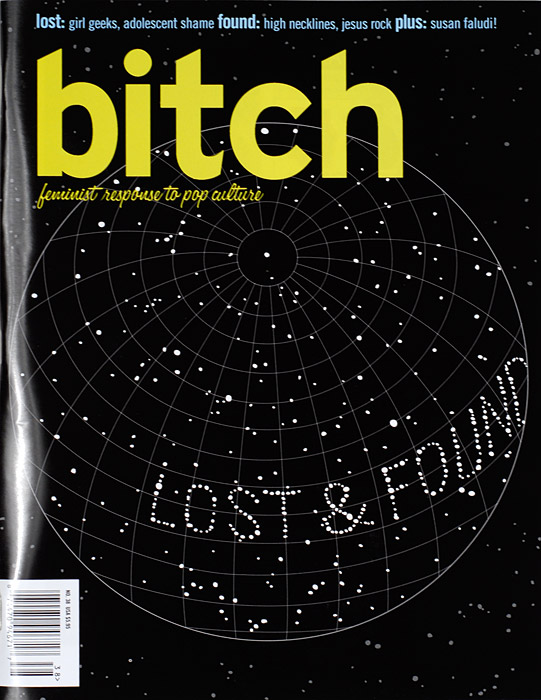
One blogger on Jewschool questioned the artistic success of a new piece by a performance artist named Maya Escobar entitled Acciones Plasticas (Plastic Dolls), in which the artist impersonates in short video segments various stereotypes that make up her identity. Her send-up of the J.A.P. was familiar to me from my years spent in a heavily Jewish, upper-middle-class suburb of Boston. Escobar's J.A.P. flips her straight dark hair and fiddles with her silver jewelry as she talks insipidly about her high-school popularity and rejection of male suitors. The blogger wrote by way of illustration, "She...nails the J.A.P. with a monologue so infuriatingly vapid and unaware it's as excruciating as the real-life experience."

[...]Using the Jewish American Princess in a deadpan manner can result in a sophisticated social critique that reveals how ridiculous the stereotype itself. The key is absurdity: Take Sarah Silverman, who frequently conjures the J.A.P. in her comedy, with mixed results [...] Maya Escobar's piece also falls in this category: by contextualizing the character in her video as a "doll" she reveals how ridiculous it is to take the character seriously. But what about the less-successful attempts at deploying the term? The reason "J.A. P." is ripe for reclamation is because it stands at the border between resonantly hateful and outdated. Although not as widely used as it once was, it still packs a punch. Therefore, if the context is not skillfully executed, the attempt serves not to interrogate or reclaim, but rather only to perpetuate the myth[...]


